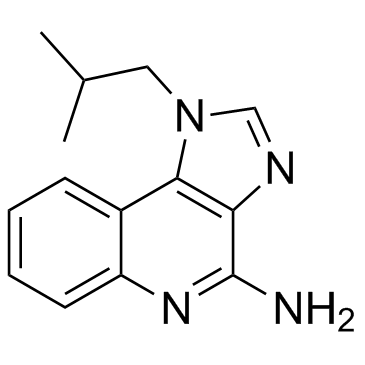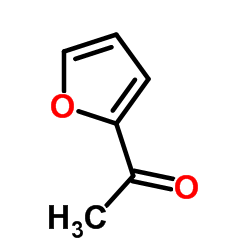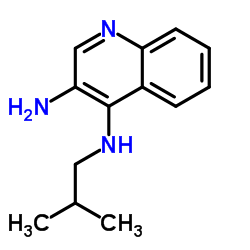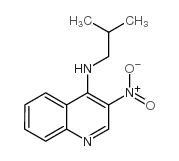imiquimod

imiquimod structure
|
Common Name | imiquimod | ||
|---|---|---|---|---|
| CAS Number | 99011-02-6 | Molecular Weight | 240.304 | |
| Density | 1.3±0.1 g/cm3 | Boiling Point | 456.7±48.0 °C at 760 mmHg | |
| Molecular Formula | C14H16N4 | Melting Point | 292-294°C | |
| MSDS | Chinese USA | Flash Point | 230.0±29.6 °C | |
| Symbol |

GHS06 |
Signal Word | Danger | |
| Purity | Quantity | Budget | Inquiry |
|---|
Use of imiquimodImiquimod is an immune response modifier and a toll-like receptor 7 agonist. |
| Name | imiquimod |
|---|---|
| Synonym | More Synonyms |
| Description | Imiquimod is an immune response modifier and a toll-like receptor 7 agonist. |
|---|---|
| Related Catalog | |
| Target |
toll-like receptor 7[1] |
| In Vivo | In animal models, imiquimod stimulates the innate immune response by increasing NK cell activity, activating macrophages to secretecytokines and nitric oxide, and inducing proliferation and differentiation of B lymphocytes. Imiquimod stimulates the innate immune response through induction, synthesis, and release of cytokines, including interferon-a (IFN-α), interleukin (IL)-6, and tumour necrosis factor (TNF)-α[1]. |
| References |
[1]. Bilu D, et al. Imiquimod: modes of action. Br J Dermatol. 2003 Nov;149 Suppl 66:5-8. |
| Density | 1.3±0.1 g/cm3 |
|---|---|
| Boiling Point | 456.7±48.0 °C at 760 mmHg |
| Melting Point | 292-294°C |
| Molecular Formula | C14H16N4 |
| Molecular Weight | 240.304 |
| Flash Point | 230.0±29.6 °C |
| Exact Mass | 240.137497 |
| PSA | 56.73000 |
| LogP | 3.46 |
| Vapour Pressure | 0.0±1.1 mmHg at 25°C |
| Index of Refraction | 1.681 |
| Storage condition | Store at +4°C |
| Stability | Incompatible with strong oxidizing agents. |
|
Imiquimod
SAFETY DATA SHEET Section1. IDENTIFICATION Product name:Imiquimod Section2. HAZARDS IDENTIFICATION GHS classification
PHYSICAL HAZARDSNot classified
HEALTH HAZARDS Acute toxicity (Oral)Category 3 Category 2 Skin corrosion/irritation Serious eye damage/eye irritationCategory 2A Not classified ENVIRONMENTAL HAZARDS GHS label elements, including precautionary statements Pictograms or hazard symbols Signal wordDanger Hazard statementsToxic if swallowed Causes skin irritation Causes serious eye irritation Precautionary statements: Do not eat, drink or smoke when using this product. [Prevention] Wash hands thoroughly after handling. Wear protective gloves/eye protection/face protection. [Response]IF SWALLOWED: Immediately call a POISON CENTER or doctor/physician. Rinse mouth. IF IN EYES: Rinse cautiously with water for several minutes. Remove contact lenses, if present and easy to do. Continue rinsing. If eye irritation persists: Get medical advice/attention. IF ON SKIN: Gently wash with plenty of soap and water. If skin irritation occurs: Get medical advice/attention. Take off contaminated clothing and wash before reuse. [Storage]Store locked up. [Disposal]Dispose of contents/container through a waste management company authorized by the local government. Section3. COMPOSITION/INFORMATION ON INGREDIENTS Substance/mixture:Substance Imiquimod Components: Imiquimod Section3. COMPOSITION/INFORMATION ON INGREDIENTS Percent:>98.0%(LC)(T) CAS Number:99011-02-6 Synonyms:1-Isobutyl-1H-imidazo[4,5-c]quinolin-4-amine , 4-Amino-1-isobutyl-1H-imidazo[4,5- c]quinoline Chemical Formula:C14H16N4 Section4. FIRST AID MEASURES Inhalation:Remove victim to fresh air and keep at rest in a position comfortable for breathing. Get medical advice/attention if you feel unwell. Skin contact:Remove/Take off immediately all contaminated clothing. Gently wash with plenty of soap and water. If skin irritation or rash occurs: Get medical advice/attention. Eye contact:Rinse cautiously with water for several minutes. Remove contact lenses, if present and easy to do. Continue rinsing. If eye irritation persists: Get medical advice/attention. Ingestion:Immediately call a POISON CENTER or doctor/physician. Rinse mouth. A rescuer should wear personal protective equipment, such as rubber gloves and air- Protection of first-aiders: tight goggles. Section5. FIRE-FIGHTING MEASURES Suitable extinguishingDry chemical, foam, water spray, carbon dioxide. media: Specific hazards arising Take care as it may decompose upon combustion or in high temperatures to from the chemical:generate poisonous fume. Precautions for firefighters: Fire-extinguishing work is done from the windward and the suitable fire-extinguishing method according to the surrounding situation is used. Uninvolved persons should evacuate to a safe place. In case of fire in the surroundings: Remove movable containers if safe to do so. Special protectiveWhen extinguishing fire, be sure to wear personal protective equipment. equipment for firefighters: Section6. ACCIDENTAL RELEASE MEASURES Personal precautions,Use extra personal protective equipment (P3 filter respirator for toxic particles). Keep protective equipment and people away from and upwind of spill/leak. Entry to non-involved personnel should emergency procedures: be controlled around the leakage area by roping off, etc. Environmental precautions: Prevent product from entering drains. Methods and materials for Sweep dust to collect it into an airtight container, taking care not to disperse it. containment and cleaning Adhered or collected material should be promptly disposed of, in accordance with up: appropriate laws and regulations. Section7. HANDLING AND STORAGE Precautions for safe handling Technical measures:Handling is performed in a well ventilated place. Wear suitable protective equipment. Prevent dispersion of dust. Wash hands and face thoroughly after handling. Use a closed system if possible. Use a local exhaust if dust or aerosol will be generated. Advice on safe handling: Avoid contact with skin, eyes and clothing. Conditions for safe storage, including any incompatibilities Storage conditions:Keep container tightly closed. Store in a cool and dark place. Store locked up. Store away from incompatible materials such as oxidizing agents. Packaging material:Comply with laws. Section8. EXPOSURE CONTROLS / PERSONAL PROTECTION Engineering controls:Install a closed system or local exhaust. Also install safety shower and eye bath. Personal protective equipment Imiquimod Section8. EXPOSURE CONTROLS / PERSONAL PROTECTION Respiratory protection: Dust respirator, self-contained breathing apparatus(SCBA), supplied air respirator, etc. Use respirators approved under appropriate government standards and follow local and national regulations. Hand protection:Impervious gloves. Eye protection:Safety goggles. A face-shield, if the situation requires. Skin and body protection: Impervious protective clothing. Protective boots, if the situation requires. Section9. PHYSICAL AND CHEMICAL PROPERTIES Solid Physical state (20°C): Form:Crystal- Powder Colour:White - Very pale yellow Odour:No data available pH: No data available Melting point/freezing point:294°C Boiling point/range:No data available Flash point:No data available Flammability or explosive limits: Lower:No data available Upper:No data available Relative density:No data available Solubility(ies): [Water]Very slightly soluble [Other solvents]No data available Log Pow:2.91 Section10. STABILITY AND REACTIVITY Stable under proper conditions. Chemical stability: Possibility of hazardous No special reactivity has been reported. reactions: Incompatible materials: Oxidizing agents Hazardous decomposition Carbon monoxide, Carbon dioxide, Nitrogen oxides (NOx) products: Section11. TOXICOLOGICAL INFORMATION Acute Toxicity:No data available Skin corrosion/irritation: No data available Serious eyeNo data available damage/irritation: Germ cell mutagenicity: No data available Carcinogenicity: IARC =No data available NTP =No data available Reproductive toxicity:No data available RTECS Number:NJ5903450 Section12. ECOLOGICAL INFORMATION Ecotoxicity: No data available Fish: Crustacea:No data available No data available Algae: Persistence / degradability: No data available No data available Bioaccumulative potential(BCF): Mobility in soil Log Pow:2.91 Imiquimod Section12. ECOLOGICAL INFORMATION Soil adsorption (Koc): No data available Henry's LawNo data available constant(PaM3/mol): Section13. DISPOSAL CONSIDERATIONS Recycle to process, if possible. Consult your local regional authorities. You may be able to dissolve or mix material with a combustible solvent and burn in a chemical incinerator equipped with an afterburner and scrubber system. Observe all federal, state and local regulations when disposing of the substance. Section14. TRANSPORT INFORMATION 6.1: Toxic substance. Hazards Class: UN-No:2811 Proper shipping name:Toxic solid, organic, n.o.s. Packing group:III Section15. REGULATORY INFORMATION Safe management ordinance of dangerous chemical product (State Council announces on January 26, 2002 and revised on February 16,2011): Safe use and production, the storage of a dangerous chemical, transport, loading and unloading were prescribed. SECTION 16 - ADDITIONAL INFORMATION N/A |
| Symbol |

GHS06 |
|---|---|
| Signal Word | Danger |
| Hazard Statements | H300-H315-H319-H335 |
| Precautionary Statements | P261-P264-P301 + P310-P305 + P351 + P338 |
| Personal Protective Equipment | Eyeshields;Faceshields;Gloves;type P2 (EN 143) respirator cartridges |
| Hazard Codes | T: Toxic;Xi: Irritant; |
| Risk Phrases | R25;R36/37/38 |
| Safety Phrases | S26-S45 |
| RIDADR | UN 2811 6.1/PG 3 |
| HS Code | 2933990090 |
~% |
| Literature: Zhurnal Obshchei Khimii, , vol. 26, p. 2716,2717; engl. Ausg. S. 3025, 3026 Bulletin de la Societe Chimique de France, , p. 1311,1315 |
~% |
| Literature: Doklady Akademii Nauk SSSR, , vol. 125, p. 345 Doklady Chemistry, 124-129 <1959> 219 |
~68% |
| Literature: Synthetic Communications, , vol. 12, # 8 p. 647 - 650 |
| HS Code | 2933990090 |
|---|---|
| Summary | 2933990090. heterocyclic compounds with nitrogen hetero-atom(s) only. VAT:17.0%. Tax rebate rate:13.0%. . MFN tariff:6.5%. General tariff:20.0% |
|
Mucolipin 1 positively regulates TLR7 responses in dendritic cells by facilitating RNA transportation to lysosomes.
Int. Immunol. 27(2) , 83-94, (2015) Toll-like receptor 7 (TLR7) and TLR9 sense microbial single-stranded RNA (ssRNA) and ssDNA in endolysosomes. Nucleic acid (NA)-sensing in endolysosomes is thought to be important for avoiding TLR7/9 r... |
|
|
Targeting cell surface TLR7 for therapeutic intervention in autoimmune diseases.
Nat. Commun. 6 , 6119, (2015) Toll-like receptor 7 (TLR7) senses microbial-derived RNA but can also potentially respond to self-derived RNA. To prevent autoimmune responses, TLR7 is thought to localize in endolysosomes. Contrary t... |
|
|
Recombinant influenza A virus hemagglutinin HA2 subunit protects mice against influenza A(H7N9) virus infection.
Arch. Virol. 160(3) , 777-86, (2015) A novel avian influenza A(H7N9) virus has emerged to infect humans in eastern China since 2013. An effective vaccine is needed because of the high mortality despite antiviral treatment and intensive c... |
| imiquimod |
| ALDARA |
| MFCD00866946 |




![1H-Imidazo[4,5-c]quinoline, 1-(2-methylpropyl)-, 5-oxide Structure](https://image.chemsrc.com/caspic/252/99010-63-6.png) CAS#:99010-63-6
CAS#:99010-63-6![4-Chloro-1-isobutyl-1H-imidazo[4,5-c]quinoline Structure](https://image.chemsrc.com/caspic/214/99010-64-7.png) CAS#:99010-64-7
CAS#:99010-64-7![4-Chloro-1H-imidazo[4, 5-c]quinoline Structure](https://image.chemsrc.com/caspic/478/132206-92-9.png) CAS#:132206-92-9
CAS#:132206-92-9![1-isobutyl-1H-imidazo[4,5-c]quinolin-4-guanidine Structure](https://image.chemsrc.com/caspic/195/1040136-68-2.png) CAS#:1040136-68-2
CAS#:1040136-68-2 CAS#:99010-09-0
CAS#:99010-09-0 CAS#:99009-85-5
CAS#:99009-85-5